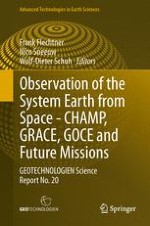Significant advances in the scientific use of space based data were achieved in three joint interdisciplinary projects based on data of the satellite missions CHAMP, GRACE and GOCE within the R&D program GEOTECHNOLOGIEN. It was possible to explore and monitor changes related to the Earth’s surface, the boundary layer between atmosphere and solid earth, and the oceans and ice shields. This boundary layer is our habitat and therefore is in the focus of our interests. The Earth’s surface is subject to anthropogenetic changes, to changes driven by the Sun, Moon and planets, and by changes caused by processes in the Earth system. The state parameters and their changes are best monitored from space. The theme “Observation of the System Earth from Space” offers comprehensive insights into a broad range of research topics relevant to society including geodesy, oceanography, atmospheric science (from meteorology to climatology), hydrology and glaciology.
